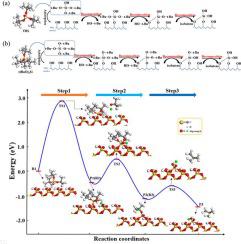Applied Surface Science ( IF 6.3 ) Pub Date : 2023-02-26 , DOI: 10.1016/j.apsusc.2023.156869
Wenling Li , Jiangong Cheng , Zilong Zheng , Qiaohong Liu , Feng Geng , Hui Yan

|
Atomic layer deposition (ALD) and rapid atomic layer deposition (RALD) have emerged as useful techniques for depositing highly conformal and uniform thin films for advanced semiconductor devices. The performance of the ALD or RALD process depends on the design of precursor molecules. In this work, the aminosilane precursor molecules (bis(tertbutylamino)silane (BTBAS), bis(diethylamino)silane (BDEAS), and tris(dimethylamino)silane (TDMAS)) in ALD and two silanol precursors (tris(tert-butoxy)silanol (TBS) and tetra(tert-butoxy)silane [(tBuO)4Si]) in RALD were investigated using first-principles based on density functional theory. The energy diagrams of the growth process on the hydroxylated SiO2(0 0 1) surface were calculated for each precursor. Furthermore, the rate-determining step was confirmed, and the precursors were compared in terms of thermochemical energies and activation barriers. BTBAS showed the lowest energy barrier in the rate-determining step among all precursors, which suggested that the rapid rate of RALD might be due to the addition of trimethylaluminum catalyst. Moreover, during the decomposition process of ALD and RALD, the bond length at the transition state demonstrated a correlation with the reaction activation energies, which provided a new perspective for studying these processes. This work helps clarify the reaction processes, facilitating the design and preparation of more efficient precursors.
中文翻译:

氨基硅烷和硅醇前体结构对原子层沉积过程的影响
原子层沉积 (ALD) 和快速原子层沉积 (RALD) 已成为为高级半导体器件沉积高度共形和均匀薄膜的有用技术。ALD 或 RALD 工艺的性能取决于前体分子的设计。在这项工作中,ALD 中的氨基硅烷前体分子(双(叔丁基氨基)硅烷 (BTBAS)、双(二乙基氨基)硅烷 (BDEAS) 和三(二甲氨基)硅烷 (TDMAS))和两种硅烷醇前体(三(叔丁氧基)使用基于密度泛函理论的第一性原理研究了 RALD 中的硅醇 (TBS) 和四(叔丁氧基)硅烷 [(tBuO) 4 Si])。羟基化SiO 2 (0 0 1) 计算每个前体的表面。此外,确定了速率决定步骤,并在热化学能和活化能垒方面对前体进行了比较。BTBAS 在所有前体中的决速步骤中显示出最低的能垒,这表明 RALD 的快速速率可能是由于添加了三甲基铝催化剂。此外,在ALD和RALD的分解过程中,过渡态键长与反应活化能存在相关性,为研究这些过程提供了新的视角。这项工作有助于阐明反应过程,促进设计和制备更有效的前体。

































 京公网安备 11010802027423号
京公网安备 11010802027423号